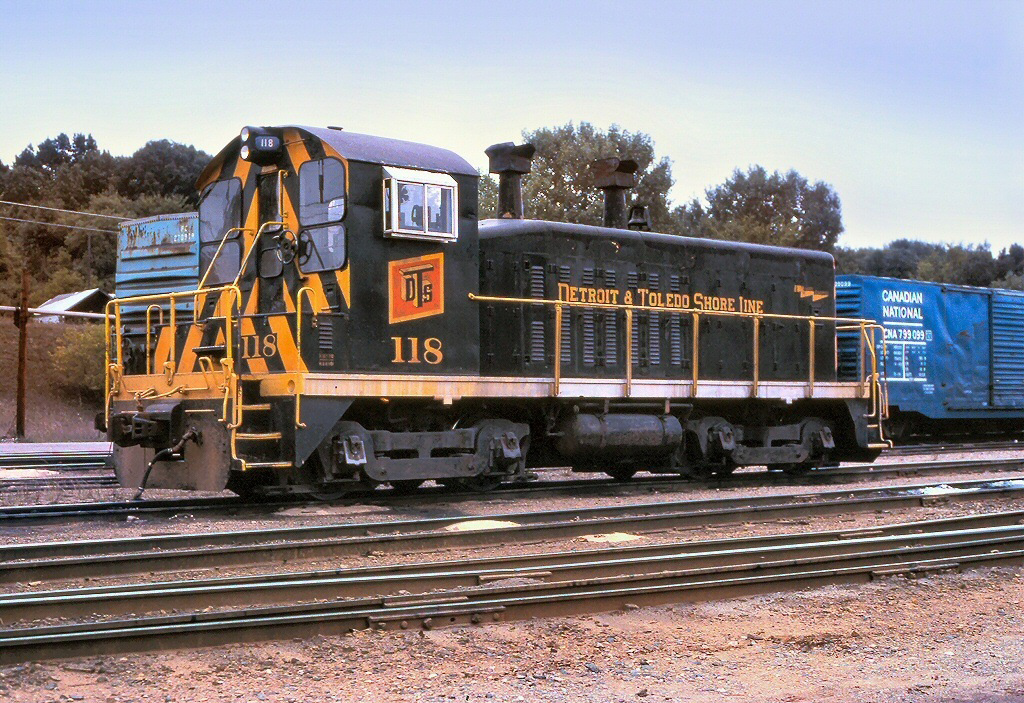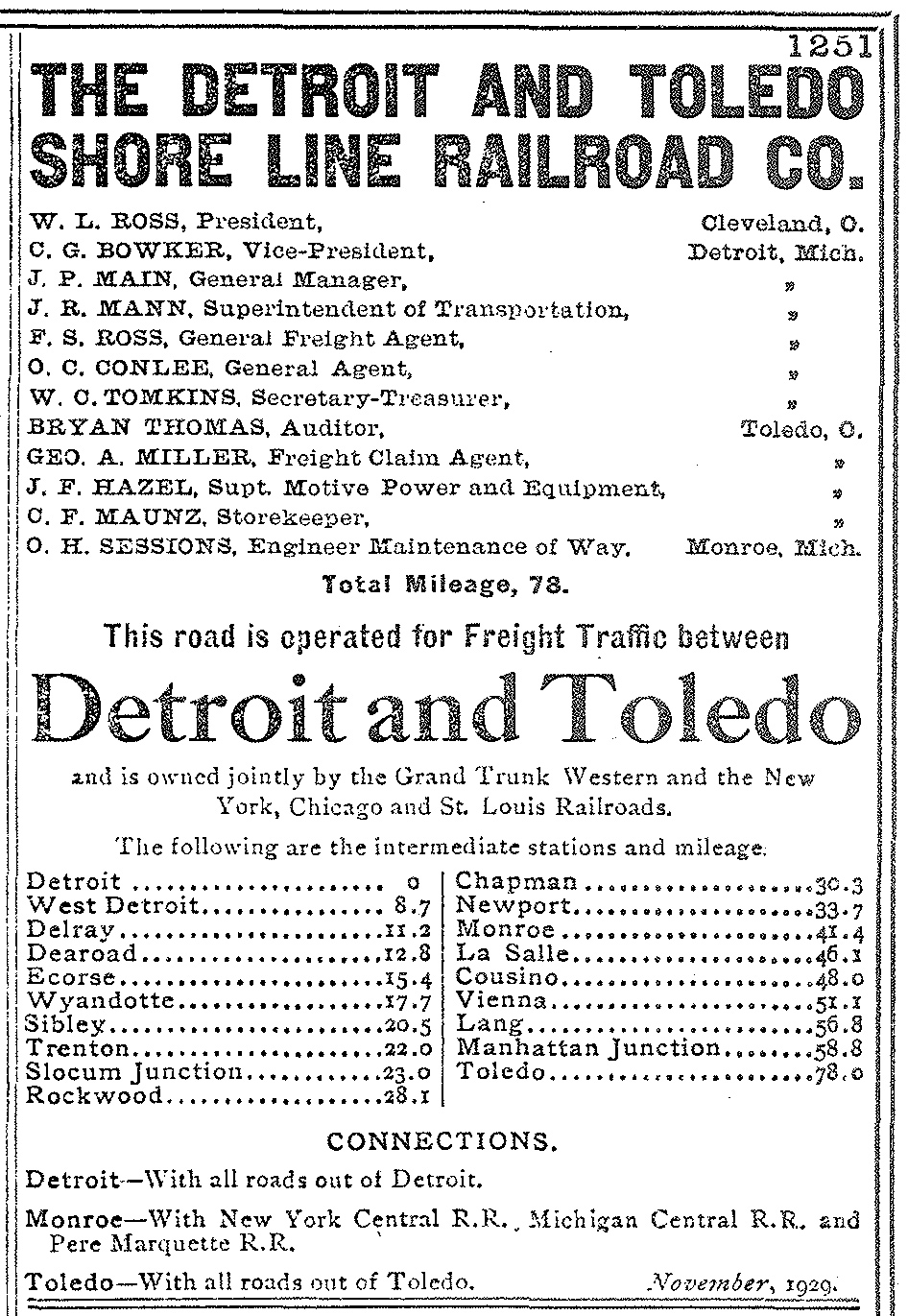Detroit & Toledo Shore Line Railroad: Map, Roster, History
Published: August 16, 2024
By: Adam Burns
The Detroit and Toledo Shore Line Railroad (D&TSL) was a notable American short line railroad that played a significant role in connecting major industrial hubs in southern Michigan and northwestern Ohio.
This terminal road was handled millions of tons of traffic between Detroit and Toledo. The D&TSL's significance is evident in its 1960 report, boasting a substantial 243 million net ton-miles of revenue freight.
The line's absorption into larger entities like Penn Central Transportation and the Norfolk & Western marked a shift in the rail landscape. It was subsuquently sold to Grand Trunk Western in 1981 and dissolved.
Its history is a story of strategic importance, robust operations, and eventual consolidation. This article delves into the formation, development, operational highlights, challenges, and the legacy of the D&TSL.
 Detroit & Toledo Shore Line SW7 #118 is waiting for the morning GTW yard crew at the east end of the yard in Battle Creek, Michigan, in September of 1983. This little engine was retired before the Canadian National takeover. Rob Kitchen photo.
Detroit & Toledo Shore Line SW7 #118 is waiting for the morning GTW yard crew at the east end of the yard in Battle Creek, Michigan, in September of 1983. This little engine was retired before the Canadian National takeover. Rob Kitchen photo.Early Beginnings and Formation
The roots of the Detroit and Toledo Shore Line Railroad stretch back to the late 19th century. The D&TSL's ancestry begins as a high-speed interurban passenger route whereupon it underwent a fascinating transformation to become a critical freight link between Michigan and Ohio.
Its genesis began with the Toledo & Ottawa Beach Railway in Ohio and the Pleasant Bay Railway in Michigan. These companies merged in 1899, forming the D&TSL under Michigan law, aiming to connect the Lake Shore Electric in Toledo with Michigan's interurban lines.
Construction commenced swiftly, with grading and bridge work beginning almost immediately. By late 1901, tracks stretched from Toledo to Trenton, with electrified sections already operational.
However, financial troubles plagued the project. By 1902, the D&TSL entered receivership. Recognizing the limited potential as an electric railway, the receiver pivoted, gaining court approval to connect with the nearby Detroit, Toledo & Ironton Railway (DT&I) at Trenton Junction. This strategic move, completed in November 1902, marked a turning point.
The D&TSL's fortunes changed dramatically when the Grand Trunk Western and the Toledo, St. Louis & Western ("Clover Leaf") railways jointly purchased the struggling line in December 1902.
They envisioned the D&TSL as a high-capacity freight route, comparable to the Grand Trunk main line. Under their ownership, the line was extended north to connect with the Wabash Railroad at River Rouge, south of Detroit.
Despite the new ownership and ambitious plans, the D&TSL remained sparsely equipped. Initially, it possessed only a handful of locomotives, some work equipment, and a single station at Monroe.
Strategic Importance and Route
The D&TSL’s primary route spanned approximately 47 miles, connecting Detroit with Toledo. This relatively short distance belied the route’s strategic significance. By linking these two industrial powerhouses, the D&TSL facilitated the efficient movement of raw materials, manufactured goods, and agricultural products.
The route primarily followed the western shore of Lake Erie, threading through a series of towns that included River Rouge in Michigan and Northwood in Ohio. The railroad’s proximity to Detroit’s thriving automotive industry and Toledo’s diverse manufacturing base ensured a steady flow of freight traffic.
The D&TSL commenced freight operations in September 1903. Initially, the D&TSL relied on its parent companies, the Grand Trunk Western (GTW) and the Toledo, St. Louis & Western ("Clover Leaf"), for locomotives and terminal facilities in Detroit and Toledo, respectively. However, the lack of passing tracks, classification yards, and locomotive servicing facilities presented immediate challenges.
Recognizing the need for infrastructure improvements, the D&TSL invested in six Baldwin compound Moguls and cabooses in the spring of 1904, immediately deploying them to enhance the right-of-way. Further development followed in 1906 with the construction of Lang Yard, a classification yard named after the company's auditor, just north of Toledo.
This yard, along with a roundhouse, turntable, and machine shop, significantly boosted operational efficiency. A second yard, Dearoad Yard, was established south of Detroit's River Rouge shortly thereafter.
Over the ensuing years, the D&TSL flourished, acquiring additional equipment and implementing numerous upgrades. Ironically, despite its initial design as an interurban passenger line, the system exclusively handled freight traffic, proving instrumental in connecting the industrial centers of Detroit and Toledo.
The Clover Leaf's absorption into the Van Sweringen's Nickel Plate system in 1922 brought its 50% stake in the D&TSL under the Nickel Plate banner.
The D&TSL's reach extended beyond its core route through operational agreements. Through service with the GTW commenced in 1921, extending D&TSL operations to Durand and Flint until the early 1940s. Furthermore, the D&TSL operated trains to Tunnel Yard in Port Huron until 1971, demonstrating its integral role in regional freight movement for several decades.
Operational Highlights
From its inception, the D&TSL focused on providing efficient and reliable freight services. The railroad’s operations were characterized by several key features:
1. **Interchange Points:**
The D&TSL established critical interchange points with its parent companies (GTW and the Clover Leaf Route) and other major railroads. These interchanges facilitated the seamless transfer of freight, enhancing the railroad’s connectivity and operational efficiency.
2. **Freight Traffic:**
The railroad transported a diverse array of freight, reflecting the economic activities of the region. Key commodities included automotive parts, steel, coal, grain, and manufactured goods. The D&TSL's ability to handle a variety of cargo contributed significantly to its financial stability.
Decline and Consolidation
Changes in the regional economy also impacted the D&TSL. The decline of some manufacturing sectors and the relocation of industries affected the volume of freight traffic.
This change also led to a general decline of the railroad industry. The Penn Central's creation in 1968 and a further decline of rail service significantly hurt terminal and bridge roads like the D&TSL.
The Norfolk & Western - which became a primary partner after its 1964 acquisition of the Nickel Plate Road - was spunoff during Penn Central's creation. In 1981 it sold its interest to Grand Trunk Western.
Operational Integration
The integration resulted in several operational changes. The D&TSL’s route maintained its importance - albeit reduced - within the Grand Trunk Western network, continuing to serve the Detroit-Toledo corridor. However, the line was slowly cutback
During the early 1990s, CN opted to restructure its American enterprises resulting in the loss of GTW's corporate image. Today, GTW remains a paper corporation only of CN's American holdings and the former D&TSL is operated as the Shore Line Subdivision.
All-Time Diesel Roster
During the steam era the railroad had largely operated 2-8-2s, 2-8-0s, and various small switchers. In the diesel era it operated models only from Electro-Motive.
This streamlined inventory fostered exceptional expertise within the D&TSL's mechanical department, resulting in a reputation for meticulous locomotive maintenance.
The fleet's workhorses were ten GP7s, tasked with road trains and some transfer duties. Three SW9s, equipped for multiple-unit operation, typically handled hump yard assignments. The remaining three SW7s, lacking multiple-unit capability, were relegated to local freights, transfer runs, and extra yard assignments, affectionately dubbed "Bum Jobs" by the crews.
While the D&TSL maintained its own distinctive units, the railroad's power pool agreement with the Grand Trunk Western (GTW) added a splash of color to the line. It was not uncommon to see GTW Geeps, GP38s, and even powerful SD40s pulling Shore Line trains or taking a breather at the Lang Yard engine facility.
Adding a touch of patriotic flair, D&TSL #46 underwent a striking transformation for the nation's Bicentennial in 1976. Renumbered to 76, the locomotive received a handsome red, white, and blue livery, commemorating the occasion in style.
| Road Number | EMD Model | Serial Number | Completion Date | GTW Number |
|---|---|---|---|---|
| 41 | GP7 | 12459 | 1/51 | 6041 |
| 42 | GP7 | 12460 | 1/51 | 6042 |
| 43 | GP7 | 15525 | 11/51 | 6043 |
| 44 | GP7 | 15526 | 11/51 | 6044 |
| 45 | GP7 | 16203 | 4/52 | 6045 |
| 46 | GP7 | 16204 | 4/52 | Renumbered 76 for Bicentennial; became GTW 6046. |
| 47 | GP7 | 16205 | 4/52 | 6047 |
| 48 | GP7 | 16206 | 4/52 | 6048 |
| 49 | GP7 | 16207 | 4/52 | 6049 |
| 50 | GP7 | 17843 | 2/53 | 6050 |
| 116 | SW7 | 11399 | 4/50 | 6116 |
| 117 | SW7 | 11400 | 4/50 | 6117 |
| 118 | SW7 | 11732 | 4/50 | 6118 |
| 119 | SW9 | 12458 | 3/51 | 6119 |
| 120 | SW9 | 16208 | 11/52 | 6120 |
| 121 | SW9 | 16209 | 11/52 | 6121 |
Cultural and Historical Legacy
The D&TSL left a lasting legacy in the railroad industry. Its contributions to regional transportation, economic development, and innovation are well-remembered. The railroad's history is preserved through archival records, historical societies, and the efforts of rail enthusiasts who recognize the significance of the D&TSL in shaping transportation in the Midwest.
The Detroit and Toledo Shore Line Railroad stands as a historical testament to the vital role shortline railroads played in regional development. From its formation in the late 19th century to its eventual consolidation in the mid-20th century, the D&TSL navigated economic shifts, technological innovations, and competitive pressures to remain a crucial transportation link in the Midwest.
As part of the Grand Trunk Western system, the D&TSL’s legacy endures in the continued importance of the Detroit-Toledo corridor for freight transportation. The railroad’s history is a reminder of an era when railroads were the lifeblood of commerce and industrial growth, and it remains a significant chapter in the story of American railroading.
Recent Articles
-
Colorado - Wine Tasting - Train Rides
Dec 25, 25 08:04 PM
To truly savor these local flavors while soaking in the scenic beauty of Colorado, the concept of wine tasting trains has emerged, offering both locals and tourists a luxurious and immersive indulgenc… -
Kentucky -Wine Tasting- Train Rides
Dec 25, 25 12:15 PM
Kentucky, often celebrated for its rolling pastures, thoroughbred horses, and bourbon legacy, has been cultivating another gem in its storied landscapes; enjoying wine by rail. -
Iowa -Wine Tasting- Train Rides
Dec 25, 25 12:12 PM
In this immersive article, passengers embark on a journey that combines the delights of wine tasting with the nostalgia of a leisurely train ride.




